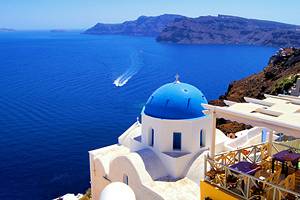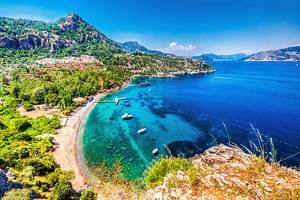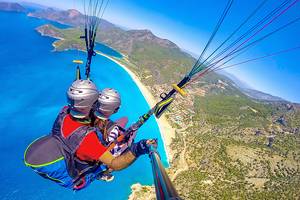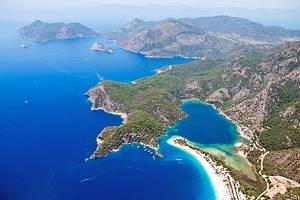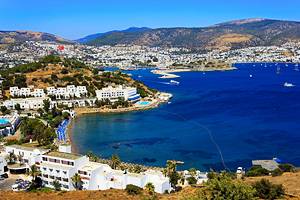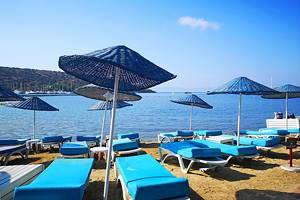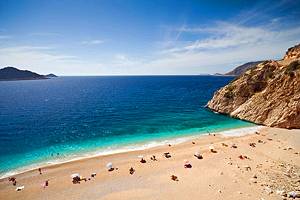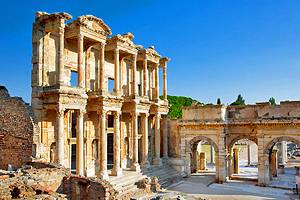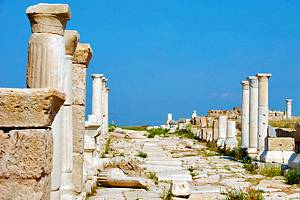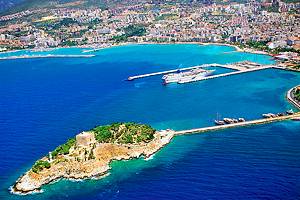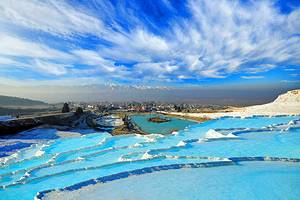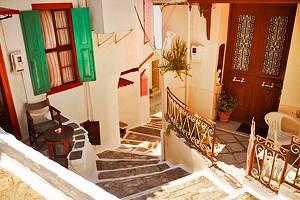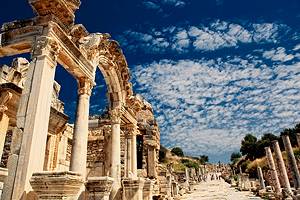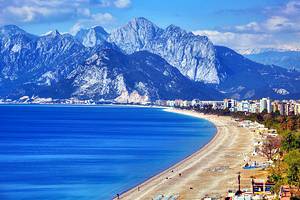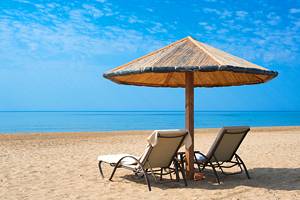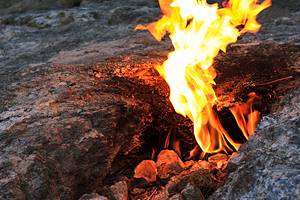Attractions & Things to Do in Rhodes Town
Dating back to 408 BCE, Rhodes Town (Ródos), on the northern tip of Rhodes Island in the Dodecanese, is a wonderful contrast between ancient and modern, with two distinct halves. The magnificent UNESCO-listed medieval Old Town lies inside the confines of the modern city but remains entirely separate, thanks to a double set of soaring walls topped with domes and minarets. Inside is a maze of narrow cobbled streets and squares, where you'll find many of Rhodes top attractions. It's a pleasure to wander.
Through the centuries, Rhodes was held by the Greeks, the Knights of St. John, the Ottoman Turks, the Italians, and then Greece again, and as a result, the architecture is a stunning mix of everything from Classical to Ottoman to Italian.
By contrast, the New Town, which lies mainly to the north, overlooks the busy port where cruise ships sailing the Eastern Mediterranean make ports of call, and is filled with shops and restaurants. The town's main beach, Elli Beach, is also here. Plan your vacation with our list of the top things to do in Rhodes Town.
Palace of the Grand Masters

At the top of the Street of the Knights, the Palace of the Grand Masters is a massive stronghold defended by a triple circuit of walls that sits at the highest point in the Old Town. Built on the site of an older Byzantine citadel, it was constructed by the Knights of St. John (aka Knights Hospitaller), a Catholic military order, who ruled the island from 1309 to 1522.
Based on a square plan centering on a large internal courtyard, it fell into disrepair after the departure of the knights but was rebuilt by the Italians in the 1930s as a holiday residence for King Emmanuel III, and later for Fascist dictator Mussolini. A whimsical structure with towers and crenellated ramparts, pebble mosaic floors, antiquities, and antiques, it has more than 150 rooms, but only about 20 are open to tourists.
Address: Street of the Knights (Odós Ippotón), 85100 Ródos
Town Walls

Starting from the Palace of the Grand Master, you can walk around the ramparts of the old town walls - one of the finest examples of medieval fortifications in the world. Initially built during the Byzantine period, they were extended and reinforced by the knights between the 14th and 16th centuries due to an obsessive fear of enemy attack. Measuring four kilometers in length, and in parts up to 12 meters thick, they include imposing towers, sturdy bastions, several magnificent gates, a dry moat, and artillery firing posts.
However, in 1522, after a six-month siege, the knights eventually surrendered to the Ottoman Turks. Under the Turks, Christians (the majority of Greeks) were banished from the old town.
Address: Street of the Knights (Odós Ippotón), 85100 Ródos
Archaeological Museum (Hospital of the Knights)

Constructed by the aforementioned Knights of St. John, a Catholic religious military order who dedicated themselves to stopping the spread of Islam, as well as tending to the sick and poor, this imposing hospital was built between 1440 and 1489. Fronting a beautiful herb-scented courtyard garden, it houses the city's archeological museum. Here, you will see displays of archaeological site finds from across the island, including marble statues, urns, funerary stele, and stunning mosaics.
Also of note is a white marble figure of a naked girl crouching and running her fingers through her hair that dates back to the first-century BC and is known as the Aphrodite of Rhodes.
Address: Museum Square (Plateia Mouson), 85100 Ródos
Street of the Knights

Running from the Hospital of the Knights up to the Palace of the Grand Masters, the cobbled Street of the Knights is lined with stone buildings and Gothic arches and still looks much as it would have in the 15th and 16th centuries. This is where the knights had their "Inns" - the order was divided into seven "Tongues" (England, France, Germany, Italy, Aragon, Auvergne, and Provence), each with its own "Inn," where members would convene and dine.
Address: Street of the Knights (Odós Ippotón), 85100 Ródos
Süleyman Mosque

Built in 1522, the year the Ottoman Turks took the city, this pink-and-white mosque with an elegant minaret was built to commemorate Süleyman I's conquest of the island. The Sultan, also known as Süleyman the Magnificent, was one of the most powerful leaders in the world at the time and expanded the empire deeper into Europe and North Africa during a period that would later be recognized as the Ottomans' Golden Age. Under the Turks, most of Rhodes' numerous churches were converted into mosques.
Address: Sokrates street (Sokratous), 85100 Ródos
Roloi Clock Tower

Originally constructed at the end of the 7th century, the Roloi Clock Tower in the medieval old town is a top sightseeing attraction in Rhodes. The Byzantine structure has undergone a few rebirths since its original creation - it was damaged by an 1856 explosion and rebuilt with Baroque touches afterwards. But the best thing to do is climb to the top of the tower and take in the panoramic views of Rhodes below. Visit either early in the morning or in the late afternoon.
Elli Beach

This is the main town beach, and in summer, it can get very crowded, although the clear blue water here remains warm enough to swim through October. The beach is mostly pebbles, so it can be a bit rocky to walk or lay out on, but there are plenty of sun-loungers and umbrellas for rent in the season. Note the water here gets deep quickly, so it isn't the best option for young children. There is even a diving platform set up to leap off just offshore. There is also good snorkeling in the vicinity.
Mandraki Harbor and Commercial Harbor

The old Mandráki Harbor, dating from the city's founding in 408 BC, is protected by a long breakwater, lined by three disused windmills, with the 15th-century Fort St. Nicholas on its northern tip. Flanking the entrance to the harbor are two stone columns topped by bronze figures of a stag and a doe. Deer are the heraldic symbol of Rhodes and are still depicted on local ceramics such as plates, ashtrays, and tiles sold as souvenirs.
In times gone by, the mythical Colossus of Rhodes (a giant third-century-BC statue of Helios, a handsome Greek god and personification of the sun) is said to have straddled the entrance to the harbor where the deer now stand. Today, the Mandráki is used by yachts and excursion boats offering day trips to the nearby islands of Symi and Halki and to Marmaris on the Turkish coast.
New Town

Outside the fortifications, the so-called new town was first settled by local Greeks after the Ottoman Turks banished them from the medieval center in 1522. However, it gained its present appearance in the 1930s, when the Italians, under Mussolini, added the elegant Art Deco administrative buildings overlooking the Mandraki Harbor, including the town hall, post office, covered market, theater, and aquarium.
Between the Mandraki Harbor and the northern tip of the island, are a string of narrow sandy beaches, with sunbeds and umbrellas for hire.
Map of Attractions & Things to Do in Rhodes Town
Rhodes, Greece - Climate Chart
| Average minimum and maximum temperatures for Rhodes, Greece in °C | |||||||||||
| J | F | M | A | M | J | J | A | S | O | N | D |
| 15 9 | 15 9 | 17 10 | 20 13 | 24 16 | 28 20 | 31 22 | 31 23 | 28 21 | 24 17 | 20 13 | 17 10 |
| PlanetWare.com | |||||||||||
| Average monthly precipitation totals for Rhodes, Greece in mm. | |||||||||||
| 147 | 117 | 76 | 23 | 15 | 3 | 0 | 0 | 8 | 64 | 89 | 145 |
| Average minimum and maximum temperatures for Rhodes, Greece in °F | |||||||||||
| J | F | M | A | M | J | J | A | S | O | N | D |
| 58 47 | 59 47 | 62 50 | 68 54 | 75 60 | 83 67 | 86 72 | 87 72 | 82 68 | 75 62 | 68 55 | 61 50 |
| PlanetWare.com | |||||||||||
| Average monthly precipitation totals for Rhodes, Greece in inches. | |||||||||||
| 5.8 | 4.6 | 3.0 | 0.9 | 0.6 | 0.1 | 0 | 0 | 0.3 | 2.5 | 3.5 | 5.7 |
More Related Articles on PlanetWare.com
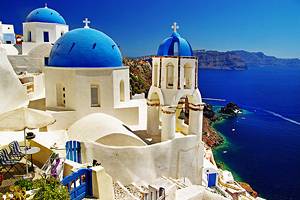
Around Greece: Begin your planning with a look at our article on the Tourist Attractions in Greece. Rhodes is just one of some 6,000 islands that are a part of Greece. If you are planning to explore the islands, be sure to read our article on the Greek Islands.
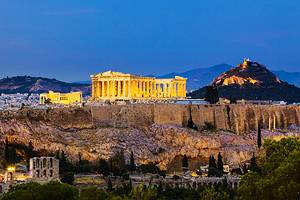
Athens: For many visitors arriving by air, Athens is the entry point to Greece. If you're a history buff (or even if you aren't) you should plan on spending at least some time in Athens, which is the heart of ancient Greece. For more on what to see and do here, check out our article on the Attractions & Things to Do in Athens.


